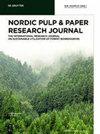Use of secondary condensates from evaporation as washing liquid in kraft pulp bleaching
IF 1.2
4区 农林科学
Q3 MATERIALS SCIENCE, PAPER & WOOD
引用次数: 0
Abstract
This study investigates the role of secondary condensates in the pulp and paper industry’s journey to minimize its water footprint. The integration of secondary condensates, traditionally less explored in bleaching processes, is examined for its potential in reducing freshwater demand. Condensates with different organic content (chemical oxygen demand, COD) and their mixtures were tested as washing liquid after the alkaline extraction stage (将蒸发产生的二次冷凝物用作牛皮纸浆漂白的洗涤液
本研究调查了二次冷凝物在纸浆和造纸行业最大限度减少水足迹过程中的作用。二次冷凝液在漂白工艺中的应用历来较少,本研究探讨了二次冷凝液在减少淡水需求方面的潜力。测试了不同有机物含量(化学需氧量,COD)的冷凝物及其混合物,将其作为球叶桉牛皮浆碱性提取阶段(E P)后的洗涤液,并与热水进行了比较。随后的两个二氧化氯阶段用于评估洗涤液 COD 对纸浆特性和化学品消耗的影响。尽管冷凝液的有机物含量较高,但它仍可部分或完全替代热水,而不会严重影响纸浆的特性,如白度、还原性和粘度。计算得出的 ClO2 消耗量与洗涤液中 COD 之间的相关性可用于评估经济和环境权衡,为优化工艺和减少环境影响提供路线图。
本文章由计算机程序翻译,如有差异,请以英文原文为准。
求助全文
约1分钟内获得全文
求助全文
来源期刊

Nordic Pulp & Paper Research Journal
工程技术-材料科学:纸与木材
CiteScore
2.50
自引率
16.70%
发文量
62
审稿时长
1 months
期刊介绍:
Nordic Pulp & Paper Research Journal (NPPRJ) is a peer-reviewed, international scientific journal covering to-date science and technology research in the areas of wood-based biomass:
Pulp and paper: products and processes
Wood constituents: characterization and nanotechnologies
Bio-refining, recovery and energy issues
Utilization of side-streams from pulping processes
Novel fibre-based, sustainable and smart materials.
The editors and the publisher are committed to high quality standards and rapid handling of the peer review and publication processes.
Topics
Cutting-edge topics such as, but not limited to, the following:
Biorefining, energy issues
Wood fibre characterization and nanotechnology
Side-streams and new products from wood pulping processes
Mechanical pulping
Chemical pulping, recovery and bleaching
Paper technology
Paper chemistry and physics
Coating
Paper-ink-interactions
Recycling
Environmental issues.
 求助内容:
求助内容: 应助结果提醒方式:
应助结果提醒方式:


